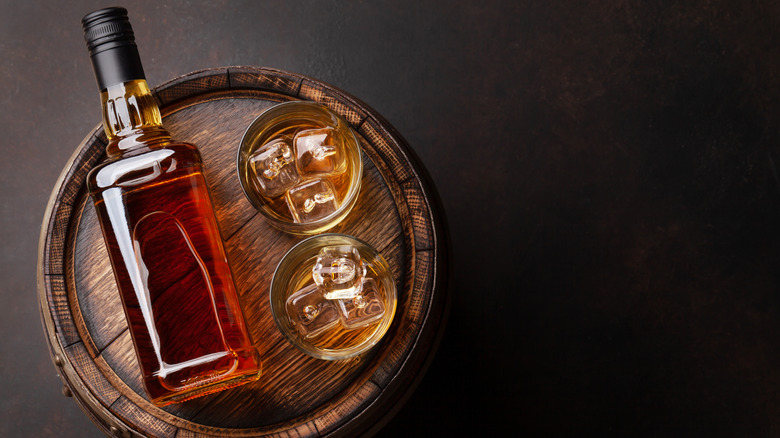What's The Difference Between Bourbon And Whiskey?
Despite being one of the easiest cocktails to make, there's much debate on how to craft a proper Old Fashioned. This drink's hazy history can be traced to James E. Pepper, a bartender and whiskey producer, per Thrillist. However, that's as clear as it gets.
According to Whiskey Rebellion Trail, it was commonplace for bar patrons in the 1860s to order liquor — whatever it may be — with sugar water and botanical spirits, or "bitters." Because this drink was mostly based on individual preference, there was no specific name it went by. But when the term "Old Fashioned" was coined by Pepper for the first time, a considerable debate ensued on whether it was at The Pendennis Club in Louisville, Kentucky, or in the Big Apple (Thrillist).
Like its initial mid-19th-century creation, this drink is still left up to personal preference. Cherries, oranges, lemons, smoking techniques, glass type, and liquor all vary. Yet, there are two things everyone can agree on. First, shaking rather than stirring would be a crime (sorry, James Bond). Second, no matter the variation, three essential ingredients are required to make an Old Fashioned: sugar water, bitters, and aged bourbon — or is it whiskey? What's the difference, and why can't we ever seem to get it right?
Whiskey vs. Bourbon
Whiskey is an internationally manufactured liquor with various techniques and combinations of flavors. As noted by Britannica, distilled whiskey comes from a blend of different grains, such as rye, wheat, corn, and barley. It is then placed in wooden barrels for the aging process, and after waiting a few years, it is bottled and distributed. Depending on where and how whiskey (or "whisky") is made, it can vary in taste and flavor (per Master Class). Canadian whisky, like Crown Royal, is well-known as a light liquor with caramel and citrus-like notes. Jameson and other Irish whiskeys lean more towards sweet and spicy tones and are usually made from malt and barley.
For a whiskey to be considered bourbon, Food & Wine reports that it must be made from a grain blend of 51% corn, aged for two years in an unused charred oak barrel, and manufactured in America. Bourbon is typically sweeter, more oak-flavored, and contains no added flavors or coloring agents. It also follows a strict distilling process. But despite the unique differences between bourbon and whiskey, the two are often mistaken for each other. For example, Jack Daniel's is often referred to as a bourbon rather than a Tennessee whiskey because of its similar distilling process and blended mash. However, the company states that its pre-aged whiskey contains 10% less alcohol by volume (140 proof) compared to a bourbon's normal requirement of at least 160 proof.
Bourbon and whiskey as kitchen aids and collector's items
But, back to the pressing issue of what constitutes a proper Old Fashioned, it is perfectly fine to use either bourbon or whiskey. Both offer a smoky, sweet, and strong kick to the drink, and when mixed with sugar water and bitters, it becomes an age-old classic cocktail. But if you really want to take it back, Thrillist explains that it was first made with gin in an 1862 bartending book.
Still, bourbon and whiskey can be used for much more than mules and sours. Besides great cocktails, bourbon makes an excellent tenderizing marinade for chicken, beef, or whatever is on the menu. It's also a great way to introduce a smoky and caramelized element to jams, sauces, and baked goods. Whisky, on the other hand, is great for desserts, according to BBC Good Food. Pudding, tarts, pies, and cake can all benefit from the savoriness of a splash of whisky.
Lastly, they are popular — and expensive — collector's items. So, if you have a few extra dollars to spare, then you're in luck. Some rare 1984 bourbons cost upwards of $30,000, but compared to a $1.9 million bottle of Macallan whisky, the first seems a little more doable. However, the most expensive whisky yet to be purchased is Isabella's Islay — a diamond and ruby-studded bottle selling for a mere $6.4 million, per Restaurant Clicks. A one-ounce cocktail of this would equal nearly $256,000. Who's picking up the tab?


